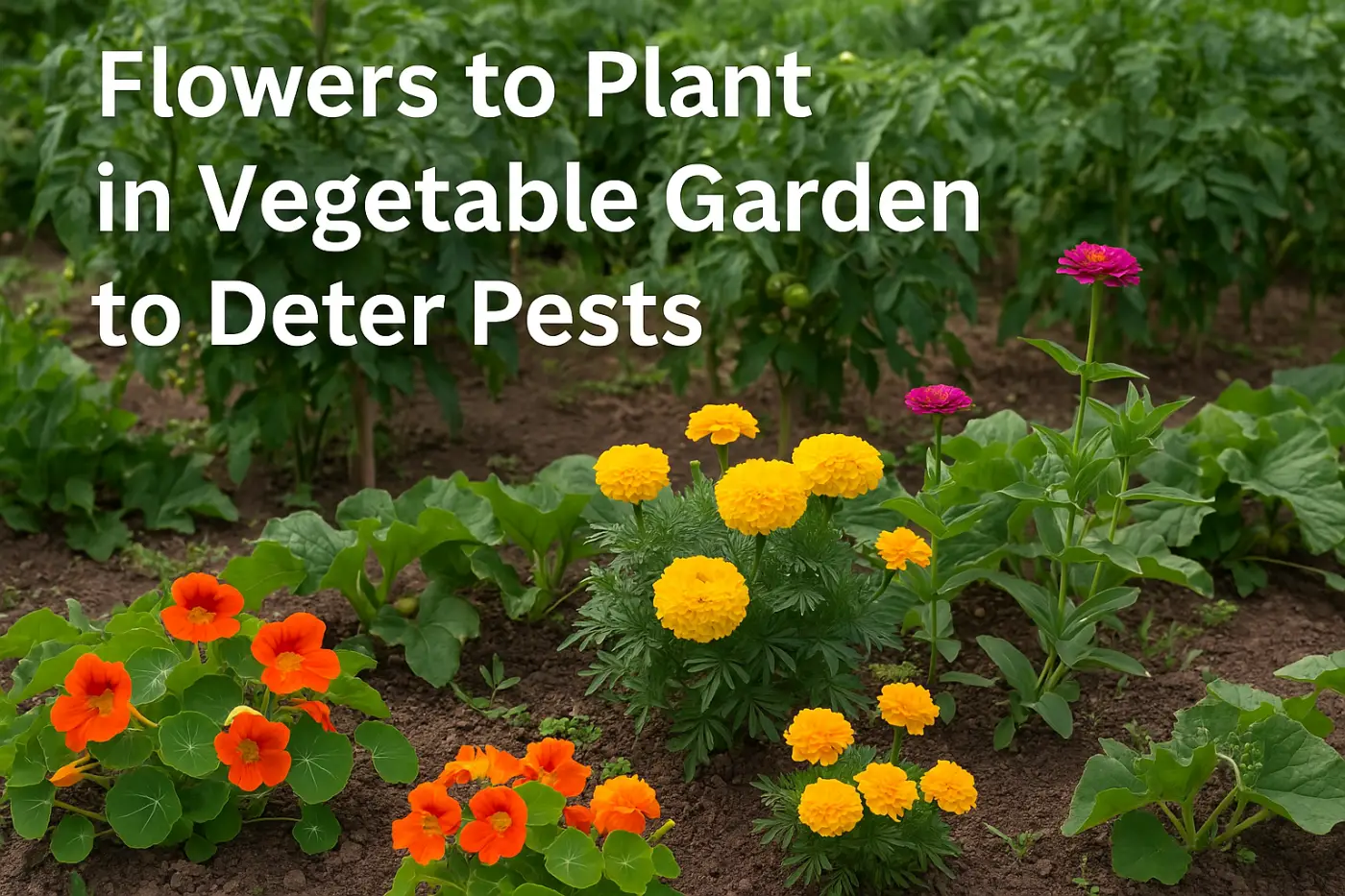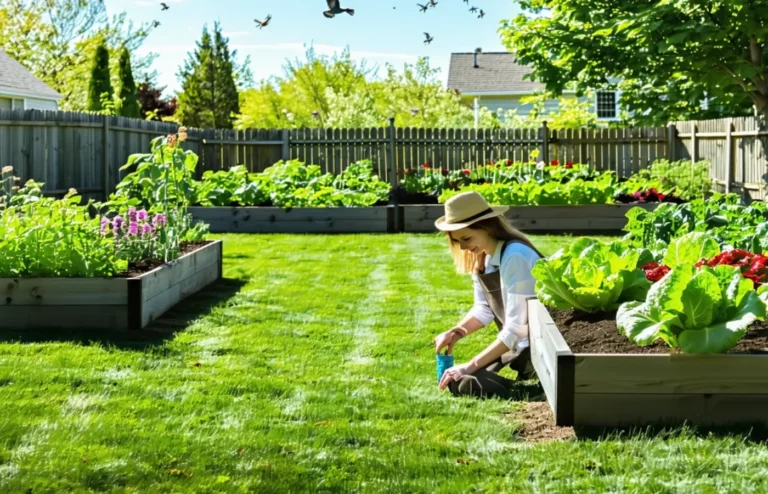
Flowers to Plant in Vegetable Garden to Deter Pests Naturally
Summary of this article
Why Plant Flowers to Repel Pests?
Chemical pesticides may be effective, but they can also be harmful to pollinators, pets, and people. Flowers provide a natural pest control solution by:
- Emitting scents that repel harmful insects.
- Attracting beneficial insects like ladybugs, lacewings, and parasitic wasps.
- Creating habitats for pollinators which improve vegetable yields.
- Confusing pests through color, scent, and spatial disruption.
According to the University of California Agriculture and Natural Resources department, “strategic planting of flowering plants can significantly reduce the impact of insect pests in vegetable crops without synthetic pesticides” (UCANR, 2023).
Top 10 Flowers That Repel Pests in Vegetable Gardens
Here’s a detailed look at ten proven flowers you can plant alongside vegetables to deter unwanted pests.
1. Marigolds (Tagetes spp.)
Best Against: Aphids, nematodes, whiteflies, beetles
Good Companions: Tomatoes, peppers, beans, squash
Marigolds are the gold standard in pest-deterring flowers. Their strong scent confuses aphids and whiteflies, and they contain compounds in their roots that suppress nematodes in the soil.
“French marigolds are particularly effective against root-knot nematodes,” – North Carolina State University Extension
2. Nasturtiums (Tropaeolum majus)
Best Against: Aphids, whiteflies, squash bugs
Good Companions: Cucumbers, squash, tomatoes, beans
Nasturtiums act as a trap crop, luring pests away from vegetables. Plus, their edible flowers add a peppery flavor to salads.
3. Calendula (Calendula officinalis)
Best Against: Aphids, asparagus beetles, thrips
Good Companions: Asparagus, carrots, lettuce, peas
Also called “pot marigold,” calendula is not a true marigold, but it attracts beneficial insects like hoverflies and parasitic wasps that feed on pests.
4. Lavender (Lavandula spp.)
Best Against: Moths, fleas, ticks, mosquitoes
Good Companions: Cabbage, broccoli, cauliflower
Lavender’s powerful scent deters many insects and also creates a calm and aromatic garden ambiance.
5. Borage (Borago officinalis)
Best Against: Tomato hornworms, cabbage worms
Good Companions: Tomatoes, strawberries, squash
Borage improves soil health and attracts pollinators, while its hairy leaves repel some common caterpillars.
6. Petunias (Petunia spp.)
Best Against: Aphids, leafhoppers, tomato hornworms
Good Companions: Tomatoes, peppers, beans
Petunias are called “nature’s pesticide” because they repel a wide variety of insects and grow well in containers or ground.
7. Chrysanthemums (Chrysanthemum spp.)
Best Against: Roaches, ants, beetles, ticks
Good Companions: General repellent — best on garden borders
Mums contain pyrethrin, a compound used in natural insecticides. A border of mums can reduce overall pest pressure.
8. Sweet Alyssum (Lobularia maritima)
Best Against: Aphids
Good Companions: Lettuce, broccoli, kale
This low-growing flower attracts hoverflies, whose larvae are voracious aphid eaters.
9. Tansy (Tanacetum vulgare)
Best Against: Ants, beetles, squash bugs
Good Companions: Cucumbers, squash, corn
Tansy can be invasive in some areas but is a powerful repellent when used responsibly. Check local guidelines before planting.
10. Sunflowers (Helianthus annuus)
Best Against: Aphids (as a trap), caterpillars
Good Companions: Corn, squash, beans
Sunflowers can act as a physical barrier and trap crop, drawing pests like aphids and stink bugs away from your veggies.
Companion Planting Flower Chart
Here’s a quick-reference HTML table for easy planning:
| Flower | Main Pests Repelled | Vegetables Benefited |
|---|---|---|
| Marigold | Aphids, nematodes, whiteflies | Tomatoes, beans, squash |
| Nasturtium | Aphids, squash bugs | Tomatoes, cucumbers |
| Calendula | Thrips, aphids | Asparagus, lettuce |
| Lavender | Moths, fleas | Brassicas (cabbage family) |
| Borage | Hornworms, cabbage worms | Tomatoes, strawberries |
Tips for Planting Flowers in Your Veggie Garden
To maximize the benefits of flower companions:
- Interplant flowers every few feet within vegetable beds, not just around the edges.
- Stagger bloom times to maintain continuous protection throughout the growing season.
- Choose native or regionally-adapted varieties for your USDA hardiness zone.
- Avoid pesticides that may harm beneficial insects attracted by your flowers.
Bonus: Attract Pollinators While Fighting Pests
Many pest-repelling flowers also draw bees and butterflies, making them multitasking garden heroes.
A 2022 study by the American Society for Horticultural Science showed that gardens with a mix of vegetables and insectary flowers had 25% higher pollination rates and 15% fewer pest outbreaks compared to monoculture plots.
Beauty That Works Hard
Incorporating flowers into your vegetable garden is one of the easiest and most effective steps toward a healthier, more productive, and more sustainable garden.
You’ll reduce the need for chemicals, support pollinators, and add vibrant color and fragrance to your backyard.
So next time you plan your vegetable patch, don’t forget to make room for these hard-working blossoms — they’re more than just pretty faces.



Laisser votre commentaire